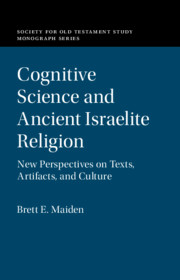Book contents
- Cognitive Science and Ancient Israelite Religion
- Society for Old Testament Study Monograph Series
- Cognitive Science and Ancient Israelite Religion
- Copyright page
- Contents
- Figures
- Tables
- Acknowledgments
- 1 Intuitive and Reflective Cognition, Optimal and Costly Religion
- 2 Rethinking the Popular–Official Religion Dichotomy
- 3 Deuteronomic Theology as Cognitively Costly Religion
- 4 Counterintuitive Mischwesen
- 5 On Artifacts and Agency
- 6 Ritual and Cognition in Leviticus 16 and the Day of Atonement Ritual
- 7 Conclusion
- Bibliography
- Index of Biblical Texts
- Subject Index
4 - Counterintuitive Mischwesen
Hybrid Creatures in Syro-Palestinian Iconography and Cognition
Published online by Cambridge University Press: 17 September 2020
- Cognitive Science and Ancient Israelite Religion
- Society for Old Testament Study Monograph Series
- Cognitive Science and Ancient Israelite Religion
- Copyright page
- Contents
- Figures
- Tables
- Acknowledgments
- 1 Intuitive and Reflective Cognition, Optimal and Costly Religion
- 2 Rethinking the Popular–Official Religion Dichotomy
- 3 Deuteronomic Theology as Cognitively Costly Religion
- 4 Counterintuitive Mischwesen
- 5 On Artifacts and Agency
- 6 Ritual and Cognition in Leviticus 16 and the Day of Atonement Ritual
- 7 Conclusion
- Bibliography
- Index of Biblical Texts
- Subject Index
Summary
This chapter uses current theories in the cognitive science of religion (CSR) to examine the widespread popularity of hybrid monsters in ancient Syro-Palestinian and Near Eastern art and the role of material culture in enhancing memory and expanding the ordinary boundaries of the religious imagination. The chapter analyzes the iconography of hybrid figures from the perspective of two current cognitive frameworks: Dan Sperber’s epidemiological approach to cultural representations and Pascal Boyer’s theory of minimally counterintuitive (MCI) concepts. Artifacts and imagery include hybrid creatures on glyptic and minor art, monsters and demons, as well as a discussion of hybrid creatures such as the seraphim and cherubim in the biblical books of Isaiah and Ezekiel. It is argued that culturally specific depictions of hybrid animals exhibit a core set of properties, which helps to account for their stability across geographical and temporal distances. The MCI theory is also empirically tested with recourse to the ancient iconographic data.
Keywords
- Type
- Chapter
- Information
- Cognitive Science and Ancient Israelite ReligionNew Perspectives on Texts, Artifacts, and Culture, pp. 133 - 176Publisher: Cambridge University PressPrint publication year: 2020

